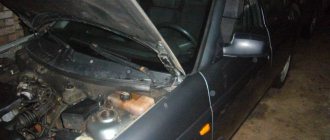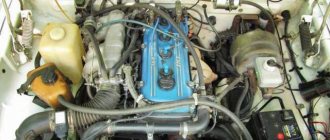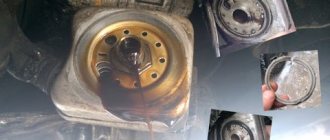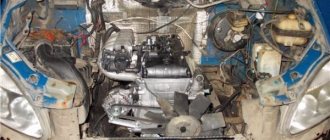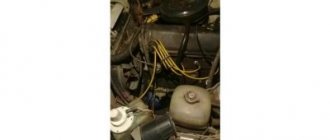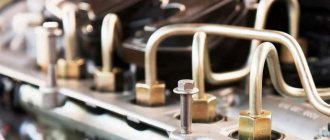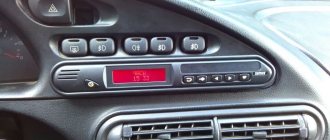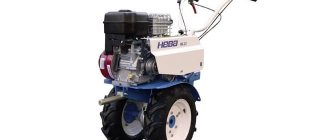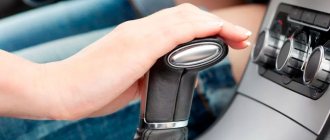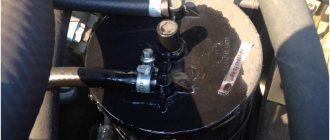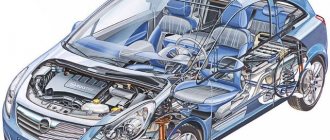When a car engine is running, its fuel system is constantly at risk of contaminants depositing on its elements (injectors, fuel lines, pressure regulator, intake valves, fuel rail). All these dangers are primarily contained in the fuel; of course, the quality of the fuel has improved recently, but it is still far from being comparable to foreign analogues. By the way, good fuel contains additives that do not allow contaminants to accumulate in the fuel system and clean the engine combustion chamber.
Fuel injector - what is it?
The injector is an important mechanism of the fuel system and is intended for timely and dosed supply of fuel into the combustion chamber of the internal combustion engine.
It is a mechanical fuel sprayer into the engine cylinders. Its main feature is to ensure precise dosage of fuel injection at a certain time point.
In the modern automotive industry, these parts are used on both gasoline and diesel engines, since they provide fuel supply in strictly limited portions and at a given point in time.
The development of this fuel supply system in automobiles began in the 60s. Currently, there are three types of injectors depending on the injection method:
- The electrohydraulic version is used in engines running on diesel fuel, as well as in engines with a Common Rail fuel system . It has a more complex device, structurally consisting of a control chamber, a valve, an inlet throttle and a drain channel. Its operation is based on the use of the already existing high pressure of the fuel mixture in the system. At the initial stage, the valve is closed and the needle is pressed as much as possible against its seat in the control chamber. Then the valve opens and fuel enters the injector through the drain throttle. It flows from the control chamber into the drain line. At this time, the intake throttle prevents the rapid equalization of pressure in the combustion chamber and in the intake manifold. In this case, as the pressure on the piston decreases, its clamping force weakens, and since the pressure on the needle does not change, it rises, and at this moment fuel is injected. A description of the operating principle of this type gives an understanding of why a diesel injector leaks.
- An electromagnetic injector is usually installed in gasoline engines . They have a simple device consisting of a solenoid-type valve, a nozzle and a spray needle. The operating principle of this type of part is also simple. Voltage is supplied to the injector winding strictly at the set time, in accordance with the programmed program. The voltage creates a certain electromagnetic field, which pulls the weight with the needle out of the valve, thereby opening the nozzle to inject the required amount of fuel. After which the voltage decreases, the needle returns to its original position and the nozzle closes. A description of the operating principle of this type gives an understanding of why injectors on a gasoline engine leak.
- The piezoelectric variety is by far the most advanced and promising among the three listed devices for injecting fuel into engine cylinders . Its scope of application is diesel internal combustion engines with a Common Rail fuel supply system. Structurally, it consists of a pusher, a special piezoelectric element, and a needle. It works on the principle of a hydraulic mechanism. Initially, the needle is placed in the valve seat due to the high pressure of the vehicle acting on it. After an electrical signal is applied to the piezoelement, its length increases and it literally pushes the pusher piston, which in turn pushes the switch valve piston. This leads to the opening of the switching valve, through which fuel flows into the drain line, the pressure in the upper part of the needle decreases and, due to the unchanged pressure from below, the needle rises. When the needle rises, fuel is injected.
Fuel injectors have a number of advantages over carburetors:
- saving fuel consumption thanks to an accurate dosing system;
- minimum level of exhaust toxicity;
- possibility of increasing motor power up to 10%;
- simplicity and ease of starting in any weather;
- no need for frequent replacement and cleaning.
All these advantages allow you to reduce the cost of operating and maintaining your vehicle. This part is very demanding on the quality of fuel and engine oil, as a result of which it often leaks.
Prevention is better and cheaper than treatment!
It should be noted that, as with most technical issues. vehicle maintenance, prevention is always better and cheaper than treatment (repair). One of the simplest, cheapest and most effective ways to prevent fuel injection problems is to maintain a healthy ignition system. One of the most important conditions for the “health” of injectors is cleanliness! It is important to refuel with high-quality fuel and change filters on time. Also, to prevent contamination of injectors, as well as combat deposits, experts recommend using a special liquid to clean fuel injectors. In addition, there is a “flush” that allows you not only to prevent the accumulation of dirt and deposits, but also to completely clean the fuel injector system.
Fuel injector cleaner is a fuel additive that is easy to use and great for preventive maintenance. At the same time, it is relatively inexpensive, especially when compared with engine repair or replacement of injectors. Some mechanics recommend using flushing fluid every time you fill up, but if you are confident in the quality of your fuel, this is unlikely to be necessary. In all other cases, if you notice any of the above symptoms, use a flush to prevent more serious problems. It is also a good habit that many motorists have - using injector flushing additives every time they change the engine oil.
If your problem is more serious, then you will most likely need to consider having your fuel injectors professionally cleaned. Of course, this will cost much more than flushing liquid, but the result will be much better. And besides, it is much cheaper than replacing injectors or repairing the engine.
How to check an injector nozzle for serviceability
How to check the serviceability of an injector nozzle
Problems with injectors occur both on cars powered by diesel fuel and on gasoline injection cars. An injector is a part responsible for injecting fuel under a certain pressure. It is useful to know how to check the injector nozzle if starting difficulties occur.
Causes and symptoms
Accurate metering of fuel, tightness of hoses and seals, activation of the injector at the right moment are prerequisites for stable and trouble-free operation of the engine. If the injection part leaks, as they say, then the efficiency of fuel atomization deteriorates, i.e., the shape of the flame is upset and the power unit smokes, either black or gray, it is difficult to start, consumption increases, and power is lost.
“The injector is leaking” is an expression that means fuel is leaking at a time when it is not needed.
There are many culprits for poor performance. For example, a dirty filter, a non-working fuel pump or bad spark plugs. The same thing happens due to the fault of a failed reel or due to problems with the timing belt.
If it is pouring, the injector is leaking
The most important symptom of a non-working injector is difficulty starting the internal combustion engine. This is especially true for a “cold” engine. In addition, as mentioned above, symptoms include increased fuel consumption and unstable engine operation in idle mode. The last symptom generally resembles almost a tripping of the engine, as if one of the cylinders is not working.
As for the driving signs of a non-working injector.
- The car moves jerkily, especially when trying to accelerate. The accelerator pedal is dull.
- Jerking while driving, after changing gears or releasing the gas pedal.
- There is an undisguised fiasco in traction and aphasia of dynamics during acceleration or maneuver.
Defects in injection elements should be corrected immediately, otherwise it will negatively affect the service life of the engine and gearbox. Experts also do not recommend driving with a faulty injector, because it is simply dangerous. On steep climbs, when maneuvering and overtaking, a car with a failed injector can play a cruel joke on the driver.
How is diagnostics carried out?
You should know that car injectors are classified into several types. Today, two of them are in use: conventional and electric injection elements (magnetic).
Electric or, more correctly, electromagnetic injectors (EMF) are equipped with a special valve that supplies fuel. It, the valve, is controlled by the power unit ECU using sent pulses.
As for mechanical injectors, they open as the gasoline pressure in the injector increases, i.e., automatically.
On modern cars, the first variants of injectors are often installed - EMF.
Checking the injector itself without removing it
Injector testing can be done in several ways. However, in use
Checking the injector
the simplest of them, and this is not surprising. It makes it possible to quickly test the injectors without even removing them from the car. The fundamental factor in such diagnostics is the analysis of the noise emitted by the motor during operation.
If a muffled high-frequency noise is heard from under the hood, this indicates the importance of cleaning the injectors or a problem with one of them.
Checking power supply
It is recommended to check how the power is going. This test option is carried out only when the injectors themselves are functioning flawlessly, but difficulties are observed with starting.
Here's how this kind of diagnosis is carried out:
- the block is disconnected from the injection system;
- two wires are connected to the battery, which are simultaneously connected at the other ends to the injectors;
- Now you need to start the engine and check the presence or absence of gasoline leakage.
According to the result, the following conclusions are drawn:
- if fuel leaks, it means there is a problem in the car’s electrical circuit;
- if not, then everything is fine.
Another test option involves using an ohmmeter. This method allows you to measure the resistance on the injectors, and draw conclusions accordingly.
This is done as follows.
- You need to find out the standard parameter of the injection elements of a particular car (for example, for a VAZ - 11-15 Ohms). Some foreign cars are of greater or lesser importance.
- Next, you need to disconnect the terminal from the battery, thereby de-energizing the system.
- Remove the electrical connector from the injector using a screwdriver with a thin pin. It will be enough to snap off the special clamp installed on the block.
- After this, connect the terminals of the device to the injection parts to measure the indicator.
In this way, you can measure the compliance of the resistance indicator with the required one. If deviations from the norms are noticeable, the faulty injector is removed from the vehicle and replaced with a known good one. After this, you can check the resistance again, and be sure to evaluate the operation of the motor. If everything was done correctly, the engine characteristics should change.
Analysis of the operation of injectors on the ramp
This method already involves dismantling the fuel rail. The injectors, of course, are removed along with the ramp. Then reconnect all electrical contacts to the ramp (after all, they are thrown off during dismantling). The negative terminal of the battery, which was removed earlier, also returns to its place.
Further:
- the ramp is placed in the engine compartment so that it is possible to place a container with a printed scale under the injectors;
- the fuel supply hoses are connected to the ramp (be sure to securely fix them at the ends);
- the engine is started by the starter (it is advisable to work together with an assistant);
- while the assistant rotates the starter, you need to test the operating efficiency of all injectors (gasoline must be supplied equally to all injectors);
- at the last stage of the procedure, the ignition is turned off, the level of gasoline in the containers is checked (obviously, the level should be the same).
Anyone can check the injector nozzle with their own hands. It is not necessary to go straight to a car service center if you encounter another problem. An experienced motorist should be able to do some repairs himself.
Didn't find the information you are looking for? on our
forum
.
If you find an error, please select a piece of text and press Ctrl+Enter.
How to check that the injector is flowing
The injector can be poured into the cylinder in both gasoline and diesel engines. To ensure stable and uninterrupted operation of the engine, the injector must accurately measure and promptly inject a portion of fuel into the combustion chamber. An injector pouring into the cylinder reduces the efficiency of fuel atomization (the shape of the torch is disrupted). Black or gray smoke also appears, fuel consumption increases and engine power decreases. The engine itself starts with difficulty. There are several ways to check injection parts.
1. Checking the injector without removing it.
This is the easiest way to quickly check the injectors without removing them. The main criterion here is the sound made by the running engine. If there is a high-frequency muffled noise coming from under the hood, most likely one of the injectors is faulty or is leaking into the cylinder and needs to be cleaned.
2. Checking the power supply.
In case of problems with starting the engine and if the injector operates without failure, it is also advisable to diagnose the power supply. The procedure here is as follows:
- disconnecting the block from the injector;
- connecting two wires to the battery, simultaneously connected to the injection elements;
- starting the engine and monitoring the passage of fuel or its absence.
Based on the observation results, we can conclude:
- leaking fuel indicates a malfunction in the vehicle's electrical circuit;
- no leakage means there are no problems.
3. Diagnostics using an ohmmeter.
In this case, an ohmmeter is used to check.
In this way, injector malfunctions are determined (in particular, when it pours into the cylinder) by measuring its resistance. This happens in several stages:
- For a particular vehicle, the standard resistance value on the injector is determined. For example, for a VAZ this value is 11–15 Ohms, but for foreign cars it can differ either up or down.
- The system is de-energized, for which the terminal is removed from the battery.
- Using a thin screwdriver, remove the electrical connector from the injection element. To do this, simply unfasten the special clip located on the block.
- The wires of the measuring device are connected to the injection elements, and measurements are taken.
Through such measurements, the current resistance values are determined and compared with the passport values. If a deviation is detected, the faulty element must be removed and replaced with a new one. Then the resistance test operation is repeated. In this case, you need to evaluate the performance of the engine itself. Its characteristics should change if the actions are performed correctly.
The first signs of a leaking nozzle
A pouring nozzle is a nozzle that does not spray fuel well or simply drains it in a stream into the combustion chamber. What are the signs that the injector is not working properly? First of all, you can feel twitching at idle or during low load modes. When the engine warms up a little, the twitching will decrease, because in a warm engine the fuel evaporates much better, even if the atomization is disrupted.
If the car does not start on the first try, but only on the second or third, and before it always started normally even with a similar temperature outside, then this is also a sign of a leaking injector. The thing is that if the injector is flowing, it lets fuel through even when the engine is not running. Due to this, the pressure in the ramp drops very significantly. And due to the fact that the fuel pump only works for a few seconds during start-up and then turns off at the software level, this is not enough to ensure that there is the required pressure in the fuel rail. That is why the engine has to be started several times in order for the pressure to equalize to the required level.
In addition, if at least one of the injectors is leaking, the air-fuel mixture becomes very lean. It is known that such a mixture burns much worse and is more prone to detonation. This can be noticed by the knock sensor, but many car enthusiasts simply do not pay attention to it, mistakenly believing that it is the sensor itself that is broken.
Sometimes a flash occurs in the engine when the starter has not yet worked. This is also one of the signs that fuel is leaking from the injectors. This pop most often means that an idle spark from the ignition ignited the leaking fuel.
What is a nozzle
An injector is an integral part of the engine fuel system that supplies fuel to the cylinders at a certain time in a certain quantity. Fuel injectors are used in diesel, injection, and mono-injection power units. Today, there are several types of nozzles that are fundamentally different from each other.
How can you tell if something is wrong with the injectors? Signs of injector failure
Common signs indicating problems with the fuel injection system:
- The engine idles unstably, or even stalls at idle;
- Increased vibration at idle, increased noise;
- The engine does not start well;
- The “Check Engine” light comes on on the dashboard;
- Increased fuel consumption;
- A characteristic smell of fuel in the engine compartment, possible leakage;
- Deterioration in dynamics and drop in power.
Of course, most of the above symptoms can have more than one possible cause, and do not always indicate a faulty fuel injection system. Similar symptoms are typical for other breakdowns, for example, faulty spark plugs can cause most of the above problems.
Connecting the computer to the “brains”
A universal code system is used to clarify a specific problem that is associated with a particular part or system. This allows you to speed up the process of diagnosing and finding the causes of a car malfunction. So, for example, a faulty fuel injector is indicated by codes in the range from P0000 to P0299 (air-fuel mixture control). The last digit between P0300 - P0308, for example - 8, indicates a problem cylinder in which there is a malfunction. Therefore, the P0308 code indicates that the No. 8 cylinder has an injector problem. You can read the error code in the ECU memory by visiting a service station or purchasing an OBD scanner.
—>Auto parts and service stations —>
A modern diesel engine is a high-precision fuel supply and injection system. However, modern diesel is not the most reliable unit. In many ways, the reliability of a diesel engine is not related to the design of the system itself, but rather depends more on the quality of the fuel used in the vehicle. And since in the countries of the former USSR diesel fuel is not of the best quality, breakdowns often occur in the diesel system. Due to low-quality fuel, owners of diesel cars most often have to contact a service station to repair injectors. Unlike gasoline injectors, which are most often completely replaced and not repaired, diesel injectors can be repaired. In order to understand whether injector repair is necessary, let’s try to understand a little theory.
Signs of a faulty diesel engine injector
Most often, a malfunction of diesel injectors is detected very quickly by the driver. But if the owner of a diesel car has no experience of owning such a car, then he may not immediately recognize the breakdown. The first thing you should pay attention to is the operation of the engine. At the first stages, no signs of breakdown appear. On the contrary, the car starts to drive a little better than usual. Yes, I didn’t make a mistake now. Everything is exactly like that. The fact is that due to faulty injectors, more fuel than required may enter the combustion chamber. Because of the rich mixture, the car starts to drive better.
If you miss this moment, then a smooth ride will gradually develop into a larger breakdown. After some time, you will begin to notice that the car began to smoke when starting, and the idle speed became unstable, and the speed began to fluctuate.
At the most advanced stages, fuel consumption increases significantly, and the car begins to smoke even when driving or sharply pressing the gas pedal. Gradually, as the injector pours fuel, it will begin to flow through the rings into the oil. This may cause the engine oil level to increase and its properties to deteriorate. And this can already lead to serious repairs.
Signs of faulty fuel injectors
The main signs of clogged injectors are difficulty starting the engine; interruptions in engine operation at idle and transient mode; failures when the gas pedal is pressed too sharply; engine power is lost and acceleration dynamics deteriorate; fuel consumption increases; the toxicity of exhaust gases increases; detonation that occurs when the engine accelerates due to an increase in temperature in the combustion chamber; misfire; exhaust system pops; breakdown of the sensor that determines the oxygen level, as well as failure of the catalytic converter. When the frosty season sets in, problems with injectors are especially noticeable - a cold engine rarely starts normally.
There are two ways to clean fuel injectors:
- Cleaning injectors without removing them from the engine.
- Cleaning on an ultrasonic rack with preliminary dismantling of nozzles.
cleaning method more effective than flushing without dismantling, but the first method also cleans other parts of the system, such as the ramp, shut-off and inlet valves, high pressure pump, etc. The cost of cleaning largely depends on the engine itself, and is $10-30 per nozzle. For some domestic and foreign cars, is more economical to install new injectors than to clean old ones.
%rtb-4%
Location and principle of operation
Depending on the type of fuel system, the injector can be located in several places, namely:
- Central injection is a mono-injector, meaning that the fuel system uses only one injector mounted on the intake manifold, just ahead of the throttle valve. It is an intermediate link between a carburetor and a full-fledged injector;
- distributed injection - injector. The nozzle is installed in the intake manifold and mixes with air entering the cylinder. It is noted for its stable operation, due to the fact that the fuel washes the inlet valve, it is less susceptible to carbon deposits;
- direct injection - the injectors are mounted directly into the cylinder head. Previously, the system was used only on diesel engines, but by the 90s of the last century, auto engineers began testing direct injection on an injector using a high-pressure fuel pump (high pressure fuel pump), which resulted in increased power and efficiency compared to distributed injection. Today, direct injection is widely used, especially on turbocharged engines.
How to clean injectors
It has been proven that regular use of high-quality chemicals every 5,000 kilometers, which is poured into the fuel tank to flush the fuel system and remove carbon deposits, ensures long-term uninterrupted operation of the injectors and the fuel system as a whole, but this is only true for new cars and with regular use, and when signs of malfunction are already appearing, then it’s a direct road to a car service center.
Today, auto repair shops widely use inexpensive single-circuit units, which are containers containing a solvent, located on a mobile stand next to the engine or under the hood of the car. The working principle of this single-circuit installation is as follows.
A pressure hose is connected to the fuel rail at the inlet. The solvent, which serves as both a cleaning agent and a fuel, is drawn from the container by increasing the pressure created by an air compressor attached to the solvent container. disadvantage is that the cleaning liquid bypasses the pressure regulator , thereby not cleaning its shut-off valve and very superficially flushing the fuel rail. Moreover, there is no way to check the result of washing using diagnostics; it is completely absent on installations of this class. It is also not uncommon to use solvents of dubious origin with very low cleaning abilities. This is done in order to minimize costs and maximize profits. An example can be given of a case where workers at a well-known service station washed injectors using the most ordinary gasoline, passing it off as a special high-quality cleaning liquid. Naturally, no benefit was observed from this cleaning.
It is optimal to use a dual-circuit cleaning system , which, unlike a primitive tank with a special cleaning liquid, is highly professional equipment. The practical use of this dual-circuit stand guarantees high-quality cleaning of any engine.
This stand has its own pump that supplies a special liquid (solvent) under pressure directly into the fuel rail, and its excess passes through pressure regulators on the way back to the installation tank. This scheme promotes the most effective cleaning of all engine parts , i.e. not only the injectors, but also the pressure regulator and the fuel rail. Moreover, the metering distributor is cleaned in the electromechanical injection system. Using a solvent, carbon deposits and dirt from the intake valves in the engine, which impede the movement of the fuel mixture, as well as deposits and carbon deposits on the pistons and combustion chamber are effectively removed On engines using diesel, the injection pump (high pressure fuel pump) is effectively flushed, due to the fact that the cleaning liquid goes directly to the injection pump input.
%rtb-4%
Why is the injector leaking?
Why does the nozzle on an injection machine leak? Because the o-rings have deteriorated. Let's talk about this in more detail.
Rubber O-rings are used to eliminate air leaks and fuel leakage at the point where the injector is connected to the fuel line, in other words, for sealing. They can have an x-shaped, round or rectangular cross-section. They can be elastic, rigid, resistant to temperature changes, the negative effects of aggressive environments and various chemicals.
1. Seals on different types of injectors.
Self-ignition of the working mixture occurs due to the high degree of compression; the load on the cylinder-piston group is high. A common mechanical pump injector is screwed into the cylinder head; to ensure a tight seal, a soft metal washer is used, installed on the bottom of the landing well. Copper is most often used, less often aluminum alloys. The metal must be soft and deform when tightened to ensure a tight seal.
Injection is carried out through a mechanical drive from the camshaft through pushers with rocker arms. Fuel is supplied through a metal pipeline; the return drain line is sealed with copper washers on the fittings.
Modern interpretations of this part are controlled electronically, which makes it necessary to significantly increase the fuel inlet pressure. This led to the need to use additional seals.
Inlet or upper o-rings are found on both gasoline and diesel injectors. They serve to eliminate air leaks and fuel leakage at the point where the injector is connected to the fuel line. They are most often made of rubber, since there are no large mechanical and temperature effects. However, the requirements for the material of the rings are high in terms of elasticity and its preservation under the influence of aggressive environmental factors.
The lower seal operates under more severe conditions, so the following options are possible:
- one metal ring;
- one rubber, made of a special composition, capable of withstanding temperature and mechanical stress;
- metallic and elastic at the same time;
- no one.
2. Symptoms of faulty o-rings.
It is often quite difficult to determine what caused the damage and failure of the o-ring - errors in design, improper installation or non-compliance with operating conditions. Sometimes a malfunction can be caused by several factors acting simultaneously. As a rule, damage to the upper seal is detected by fuel leaks. It could just be a wet spot, drops or even a trickle. Leakage of fuel here is very dangerous due to the possibility of it flowing down onto the hot output manifold, which definitely leads to a fire; urgent replacement is required.
If the lower seal is faulty, air leaks in and the mixture becomes lean. The engine starts only when the gas pedal is partially pressed, idles unstably, and power decreases, especially at low speeds.
With high mileage, the rings, especially the lower ones, due to high temperatures, can simply become stiff and lose elasticity. Then the smell of gasoline appears in the cabin at low temperatures when starting. The replacement may wait a little, but you shouldn’t delay it for too long.
On some diesel engines, leaks in the lower o-rings lead to gases breaking through and entering the oil. Coke is formed, which is washed into the oil pan and clogs the oil receiver. The main symptom in this case is white acrid smoke within a few seconds after starting, and when the malfunction occurs, the oil pressure lamp blinks. This car cannot be used; faulty parts need to be replaced.
3. When to change the seals on the injectors.
During operation, visible mechanical damage appears on the rubber sealing ring of the nozzle - cracks of various sizes, loss of elasticity and other deformations. Loss of tightness can lead to serious consequences - fuel begins to leak, and this can cause a fire in the engine compartment of the car, so you should hurry up with replacing the O-rings.
When installing injectors with new sealing rings, be sure to clean the seat, remove all old rings, and clean off any remaining rubber. Place the rings on the injector by hand without using tools, lubricate the new seals with engine oil so that the seal rotates easily in the seat groove.
4. Purchase of seal rings.
If an injector leaks, sooner or later you will need to buy a new one. Along with it, the kit may also include additional elements in the form of a mesh filter, a set of necessary sealing rings, rubber mounting bushings, and plastic plugs.
Rings may be sold in auto parts stores:
- piece by piece;
- set for one nozzle (lower and upper);
- kit for the engine (the number of cylinders is taken into account).
The color of rubber O-rings can be any color and has nothing to do with size or quality.
Bosch injectors of various modifications are used on domestic and imported cars. Since the 90s, they have been unified and are better able to be repaired and restored than other similar ones when they begin to leak.
5. Step-by-step instructions for replacing O-rings on injectors.
To ensure a good seal, O-rings should be placed with slight tension, which increases the strength of the fastening. They should be replaced according to the following instructions.
- Relieve pressure in the fuel system.
- De-energize the machine's electrical components by disconnecting the battery terminal.
- Disconnect all pipes and hoses connected to the fuel rail to gain full access to the damaged element.
- Then, using a hexagon, remove the fasteners, and then remove the ramp with the injectors.
- Remove any old rings using a flathead screwdriver or knife.
- Lubricate the new O-rings with engine oil.
- Finally, return the ramp to its place. It is important to ensure that the seals are not distorted when installing it. Also, do not use excessive force to avoid damaging the elastic.
Cleaning injectors VAZ 2114
To clean the injectors, they need to be removed from the car, this is done as follows:
- From a vehicle with the engine not running, disconnect the battery terminal.
- Relieve pressure in the fuel rail. On the back there is a valve with a cap; by unscrewing it and pressing the valve with a thin screwdriver, you can release the pressure.
- For convenience, remove the air filter pipe.
- Disconnect both fuel pipes.
- Disconnect the connectors from the injectors.
- Unscrew the fuel rail.
- The injectors are removed along with the ramp; in order to disconnect them, you need to move the fixing washer and pull the nozzle.
After removal, you can begin cleaning yourself:
- Remove the O-rings from the injectors and soak for a short time in acetone or gasoline.
- After soaking, carefully clean the nozzles with a needle and remove any other external deposits.
- To clean the inside you will need carburetor cleaning fluid, a syringe, a tube that fits tightly in diameter to the injector inlet holes, and a button with wiring.
- Connect the injector through the button to the battery terminals, as you did when checking.
- Fill the syringe with liquid and connect it to the nozzle using a tube.
- Apply pressure with the syringe and press the button.
- Liquid should spray out of the nozzle.
- Repeat this procedure several times, constantly maintaining pressure with the syringe.
- After washing, it is better to immediately replace the fuel filters.
This method removes only surface deposits; for deep cleaning of VAZ 2114 injectors, send them for ultrasonic cleaning.
Causes of injector malfunction
Repair of diesel injectors may be required for the following reasons:
- Low quality diesel fuel: the scourge of all diesel drivers. Due to impurities in the fuel, the atomizer becomes clogged; the dosage and fuel supply mode are violated.
- Poor assembly quality of the injection component or manufacturing defect: the injector does not withstand operating conditions, the part as a whole or individual components fails.
- Mechanical damage caused by incorrect operation of adjacent internal combustion engine systems.
Usually the breakdowns are of the following nature: the spray angle and the amount of fuel supplied changes, the integrity of the housing is compromised, and the needle stroke worsens.
How to troubleshoot injector problems?
To identify the causes of an injector malfunction, you need to go through half of the car. It takes a lot of time and effort. Special diagnostic equipment is required.
Advanced cases occur among drivers who do not monitor the condition of the car. Requires time and material costs to fix the problem.
Many drivers have an indecently dirty injection system. Lack of competent maintenance and low-quality fuel take their toll.
Computer diagnostics.
The beginning of any renovation. Clarifies the causes of malfunctions. Special equipment is used.
Fuel injection system.
Represented by nozzles prone to contamination. It has a complex design, which makes it difficult to perform maintenance on your own without outside help.
Failure to promptly replace the fuel filter results in small dirt particles entering the injector nozzles. Normal supply of gasoline is difficult. Ultrasound is used to remove dirt and the filter is replaced.
Fuel pump.
Located in the fuel tank. Serves to supply gasoline to the injectors. Long-term operation of the pump leads to wear of its working elements.
A typical malfunction is an insufficient amount of fuel supplied to the injectors. This leads to unstable operation of the injection system. The pump cannot be repaired and must be replaced together with the fuel tank.
The injector is a reliable fuel supply system. She lost the fight to new technologies. The new generation ICE (internal combustion engine) has low fuel consumption and lower emissions of harmful substances. The injector is prone to contamination and high fuel consumption.
Thank you for your attention, good luck on your journey. Read, comment and ask questions. Subscribe to fresh and interesting articles on the site.
Other injector malfunctions and their elimination
Modern models of this part are manufactured to a tolerance of 1 micron and are capable of operating up to a billion cycles. The main reason that they begin to leak is contamination during operation, although in the path of mechanical particles there are fuel filters that filter out particles larger than 10-20 microns. They are installed in the fuel line and in the injector itself. The latter are relatively small in size and are intended only to guarantee the purity of the fuel entering the part, cutting off particularly small inclusions that have penetrated through the main fuel fine filter. Their absorption capacity is low, and when clogged, they leave the injectors starved. To prevent this, you need to carefully monitor the condition of the fine fuel filter and not pour questionable gasoline into the tank.
Signs that a part is leaking may include the following:
- when moving, jerks and jolts are felt;
- The internal combustion engine is unstable at idle speed and stalls;
- noticeable loss of power;
- increased fuel consumption;
- popping noises in the exhaust system and muffler;
- failure of individual cylinders.
At the same time, malfunctions associated with the fact that a part is leaking are easiest to notice in the winter: if they are heavily soiled or the rubber seals are worn out, the engine will be very difficult to start “in cold conditions.”
The process of dismantling the injector requires a tool, regardless of the location of the injectors in the vehicle's fuel system. Disassembly differs depending on the vehicle model and the type of fuel injection. In most cases, to replace an injector that is leaking, you will need the following tool:
- torque wrench;
- extension;
- head for injectors (usually included with the car);
- key to 17;
- tweezers;
- container for fuel, rags.
Diagnosing diesel injector leaks and servicing them involves removing the nozzles from the internal combustion engine. It is first necessary to relieve the pressure in the fuel system. To do this, disconnect the wires from the fuel pump and start the engine. The engine will exhaust the remaining fuel in the system and stall. These actions will help relieve pressure and eliminate sudden surges during unscrewing.
After preparing the tool and reducing the pressure in the fuel system, you can proceed directly to dismantling and repair:
- Remove all hoses from the injector body (a small amount of fuel may spill out, so you need to place a container under the engine in advance or cover the work area with a cloth).
- Disconnect the high pressure pipes from the part that is leaking.
- Unscrew it with a spanner.
- Remove the thermal insulation washers.
- Wipe each seat with a clean cloth to prevent dust and dirt from getting into the motor.
- The first step is to clean the part from carbon deposits and dirt. A carbicleaner is perfect for this. If such a cleaner is not available, wash the parts from carbon deposits in clean diesel fuel or acetone. The final stage of washing is to rinse the nut, injector body and nozzle in clean diesel fuel.
- Install a new sprayer. First, all elements are tightened by hand, then tighten using a spanner. Remember that at the initial stage you should not tighten the nut too much, since it is possible that you will need to disassemble the device again.
- Install the adjusting washer using the same method: unscrew the old one, install the new one in its place.
- It is recommended to replace the O-rings even in cases where the rubber is not damaged. The old rings are removed with tweezers, and new ones are pulled in their place.
- After which a small amount of fuel is applied to all rubber elements of the part.
- Before installation, you need to install new thermal insulation washers into the socket. Even if the old ones are not deformed or cracked, the washers must be changed after each removal.
- The nozzle that was leaking is put back in place and tightened with a torque wrench. This will ensure reliable fixation and ease of subsequent dismantling.
Why don't the injectors work?
Nowadays, injectors are made to a tolerance of 1 micron, which allows them to carry out about a billion cycles. The main reason why their performance is impaired is contamination during operation , despite the fact that the path to any mechanical particles is blocked by filters that filter out particles larger than 10-20 microns. The place where the filters are installed is the fuel line and the injector itself. The main cause of contamination is the inevitable presence of heavy particles in the fuel. The largest accumulation of dirt occurs after the engine is turned off. At this moment, due to the fact that the nozzle is heated by the engine, the temperature of its body increases, while there is no cooling effect of the fuel. Light particles of fuel located in the nozzle evaporate, while heavy ones settle like varnish deposits, reducing the cross-section in the calibrated channel. For example, deposits 5 microns thick can reduce the capacity of a given channel by about 25%. Contamination of the holes in the injectors prevents the formation of the fuel mixture, the shut-off valve of the pressure regulator loses its tightness, and the high-pressure fuel pump in diesel engines reduces its performance.
%rtb-4%
Diesel engine noises indicating a malfunction
Every fan knows the sound of his car's engine. As a rule, it is quiet and measured, without any admixture of extraneous noise. However, the appearance of extraneous sounds, and especially knocking, gives many vehicle owners cause for concern. The reasons for knocking can be very diverse. Some indicate the need for scheduled maintenance, others indicate serious malfunctions and the need for urgent repairs of the diesel engine.
Among all kinds of engine problems, knocking noise when running a diesel engine is the most common occurrence. It is important to distinguish engine noise from the sound of the chassis. It is impossible to determine in absentia the cause of the knocking without conducting engine diagnostics, since many elements of the system can produce similar noises. Knocking can occur either from an insufficiently tightened part or from a failed motor element. In any case, you should not postpone your visit to the car service center.
How to restore the performance of a VAZ-2114 engine: expert advice
Automotive repair experts recommend that motorists use several tips to restore the functioning of a VAZ-2114 engine that is tripping.
First tip: check and replace the electronic control unit.
Second tip: check and replace the oxygen sensor.
Third tip: check the functionality of the crankshaft position sensor. This can be done using the electronic control unit. This device will generate an error if the crankshaft position sensor is faulty. This means you will have to replace it with a new one.
Fourth tip: check and replace the ignition coil.
Fifth tip: check and replace the air filter.
Sixth tip: check the correct placement of the timing belt.
Cases when the nozzle needs to be completely replaced
Let's list the main features:
- the resource declared by the manufacturer has been exhausted;
- there are breakdowns or other leaks in the housing;
- burnt nozzle nut: if the problem is not corrected at an early stage, the nozzle itself will become unusable.
Please note that on some engines, after installing a new injector, it is necessary to “bind” it to the engine: make changes to the settings of the control unit.
It is better to install the nozzle at a service station, since the station has bench equipment for adjusting and assessing the current condition of the part.
Causes of clogged injectors
Poor quality fuel is one of the main reasons for injector failure. A huge amount of resins that settle inside the injectors reduce the throughput, they do not allow the valves to close hermetically, and thereby the angle of the injected fuel jet changes. When starting the engine in winter, a failed valve causes the mixture to become over-rich, resulting in increased fuel consumption and increased toxicity of exhaust gases. If fuel is sprayed incorrectly, disturbances occur in the mixture formation process, and this is the first reason for the deterioration of almost all engine performance. Clogging of injectors occurs when using fake fuel filters, or if the car owner simply forgot to change the filter. With pressure in the fuel system, the filter may simply rupture, and dirt will naturally enter the injectors.
Malfunctions that injectors may have
Injectors are a fairly precise mechanism; they can open and close several times per second, while providing:
- lightning-fast opening;
- good fuel flow;
- fine atomization of gasoline for better mixing with air;
- tight and fast closing.
The life of injectors is highly dependent on the quality of gasoline and the frequency of replacement of fuel filters. Any, even the smallest debris can prevent them from fulfilling their purpose.
Over time, the injectors become clogged with deposits and the following problems may occur:
- The injectors do not open immediately when a signal is given, or if they do not open at all, they become jammed.
- Less gasoline may pass through a clogged hole than the ECU calculated, this will lead to a lean mixture.
- Debris can also interfere with the atomization of fuel, causing it to flow in a stream and not mix enough with the air.
- A loose closure means that more gasoline than necessary will enter the combustion chamber.
Such malfunctions in the fuel system can, in turn, lead to the following problems with the operation of the engine as a whole:
- misfires at idle;
- significant loss of power;
- unstable engine operation;
- increased fuel consumption;
- Difficulty starting the engine.
The reason for such changes in operation may be dirty or failed injectors. They very rarely become completely unusable and you can always try cleaning them before replacing VAZ 2114 injectors.
To increase the service life, it is recommended to clean the injectors of the VAZ 2114 every 40 thousand kilometers; the service life also greatly depends on the quality of the gasoline used.
